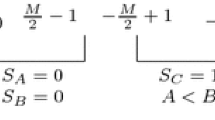Abstract
This paper presents an investigation into using a combination of two alternative digital number representations; the residue number system (RNS) and the signed-digit (SD) number representation in digital arithmetic circuits. The combined number system is called RNS/SD for short. Since the performance of RNS/SD arithmetic circuits depends on the choice of the moduli set (a set of pairwise prime numbers), the purpose of this work is to compare RNS/SD number systems based on different sets. Five specific moduli sets of different lengths are selected. Moduli-set-specific forward and reverse RNS/SD converters are introduced for each of these sets. A generic conversion technique for moduli sets consisting of any number of elements is also presented. Finite impulse response (FIR) filters are used as reference designs in order to evaluate the performance of RNS/SD processing. The designs are evaluated with respect to delay and circuit area in a commercial 0.13 μm CMOS process. For the case of FIR filters it is shown that generic moduli sets with five or six moduli results in designs with the best area × delay products.













Similar content being viewed by others
References
Lindström, A., Nordseth, M., Bengtsson, L., & Omondi, A. (2004). Arithmetic circuits combining residue and signed-digit representations. In Lecture notes in computer science (LNCS) (Vol. 2823, pp. 246–257). Springer.
Szab, N. S., & Tanaka, R. I. (1967). Residue arithmetic and its applications to computer technology. McGraw-Hill (December).
Soderstrand, M., & Jenkins, W. (1986). Residue number system arithmetic: Modern applications in digital signal processing. IEEE Press.
Wang, W., Swamy, M., & Ahmad, M. (2003). Rns application in digital image processing. In Proceedings of the 3rd IEEE international workshop on system-on-chip for real-time applications (pp. 77–80) (July).
Avizienis, A. (1961). Signed-digit number representation for fast parallel arithmetic. IRE Transactions on Electronic Computers, EC-10, 389–400.
Parhami, B. (1988). Carry-free addition of recoded binary signed-digit numbers. IEEE Transactions on Computers, 37(11), 1470–1476 (November).
Wei, S., & Shimizu, K. (2000). A novel residue arithmetic hardware algorithm using a signed-digit number representation. IEICE Transactions on Information and Systems, E83–D(12), 2056–2064 (December).
Wei, S., & Shimizu, K. (2001). Fast residue arithmetic multipliers based on a signed-digit number system. In Proceedings of the 8th IEEE international conference on electronics, circuits and systems (Vol. 1, pp. 263–266) (September).
Wei, S., & Shimizu, K. (2002). Residue signed-digit arithmetic circuit with a complement of mudulus and the application to rsa encryption processor. In Proceedings of the 9th IEEE international conference on electronics, circuits and systems (Vol. 2, pp. 591–594) (September).
Lindahl, A., & Bengtsson, L. (2005). A low-power fir filter using combined residue and radix-2 signed-digit representation. In Proceedings of the 8th EUROMICRO conference on digital system design (DSD’05) (pp. 42–47). Porto, Portugal: IEEE Computer Society Press (August–September).
Abdallah, M., & Skavantzos, A. (1995). A systematic approach for selecting practical moduli sets for residue number systems. In Proceedings of the 27th IEEE southeastern symposium on system theory (pp. 445–449) (March).
Vinnakota, B., & Rao, V. B. (1994). Fast conversion techniques for binary-residue number systems. IEEE transactions on circuits and systems I: Fundamental theory and applications, CAS-41(12), 927–929 (December).
Wang, W., Swamy, M., Ahmad, M., & Wang, Y. (1999). The applications of the new Chinese remainder theorems for three moduli sets. In Proceedings of the 1999 IEEE Conadian conference on electrical and computer engineering (Vol. 1, pp. 571–576) (May).
Wang, Y., Song, X., Aboulhamid, M., & Shen, H. (2002). Adder based residue to binary number converters for (2n − 1,2n,2n + 1). IEEE Transactions on Signal Processing, 50(7), 1772–1779 (July).
Wang, Y. (2000). Residue-to-binary converters based on new Chinese remainder theorems. IEEE Transactions on Circuits and Systems II: Analog and Digital Signal Processing, 47(3), 197–205 (March).
Cao, B., Chang, C., & Srikanthan, T. (2003). An efficient reverse converter for the 4-moduli set {2n − 1, 2n, 2n + 1, 22n + 1} based on the new Chinese remainder theorem. IEEE Transactions on Circuits and Systems I: Fundamental Theory and Applications, 50(10), 1296–1303 (October).
Skavantzos, A., & Saturates, T. (1999). Grouped-moduli residue number systems for fast signal processing. In Proceedings of the 1999 IEEE international symposium on circuits and systems (ISCAS’99) (Vol. 3, pp. 478–483) (May).
Wang, W., Swamy, M., & Ahmad, M. (2000). An area-time efficient residue-to-binary converter. In Proceedings of the 43rd IEEE midwest symposium on circuits and systems (pp. 904–907) (August).
Shallit, J. (2005). A primer on balanced binary representations. Retrieved October 2005, from http://www.cs.uwaterloo.ca/shallit/Papers/bbr.pdf.
Author information
Authors and Affiliations
Corresponding author
Rights and permissions
About this article
Cite this article
Persson, A., Bengtsson, L. Forward and Reverse Converters and Moduli Set Selection in Signed-Digit Residue Number Systems. J Sign Process Syst Sign Image Video Technol 56, 1–15 (2009). https://doi.org/10.1007/s11265-008-0249-8
Received:
Revised:
Accepted:
Published:
Issue Date:
DOI: https://doi.org/10.1007/s11265-008-0249-8




